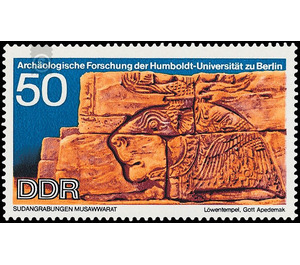Archaeological research of the Humboldt University zu Berlin - Sudangrabungen Musawwarat - Germany / German Democratic Republic 1970 - 50 Pfennig
Theme: Architecture
| Country | Germany / German Democratic Republic |
| Issue Date | 1970 |
| Face Value | 50.00 |
| Color | brown |
| Perforation | K 14 |
| Printing Type | Photogravure |
| Stamp Type | Postage stamp |
| Item Type | Stamp |
| Chronological Issue Number | 1332 |
| Chronological Chapter | GER-DDR |
| SID | 563310 |
| In 19 Wishlists | |
Archaeological Research of the Humboldt University of Berlin - Sudangrabungen Musawwarat In connection with the archaeological research of the Humboldt University of Berlin, the Ministry of Posts and Telecommunications of the German Democratic Republic issued seven multicolored special postage stamps, the motifs from the Lion Temple in Musawwarat, Democratic Republic Sudan, show. Sudan excavations Since the winter of 1957/58, the former Institute of Egyptology at the Humboldt University in Berlin (now the Department of Egyptology and Sudan Research) carries out archaeological research in Sudan aimed at developing the ancient African Merit culture and history. The Meroitic period (from 750 BCE to around 350 BCE) is the first African civilization in its proper sense, which played an important role as a mediator between the ancient Mediterranean world and the rest of Africa. Civilization, art, craft, and science flourished, and livestock and agriculture had reached a high level, and Meroe maintained trade and cultural ties of many kinds with Egypt, the Near East, Rome and Greece, Abyssinia and southern Arabia, and far into Africa. Exploring this culture and its history is an important task of the archaeological and historical sciences, as it provides the foundations for understanding the whole of Old African history. From 1960 to 1968, in Musawwarat, Sufra, an ancient place located 40 km from the Nile in the dry steppe, was excavated as a sacred center of the Meroitic empire. These excavations brought to light an unexpected wealth of new insights into the culture and history, religion and art, architecture and crafts of the Meroitic era, which have created entirely new foundations for vast areas of Sudan research. One of the most important monuments unearthed in Musawwarat is the Lion Temple excavated by us in 1960. The ruins of this building had previously received little attention because they were almost completely covered in rubble and debris. Surprisingly, it turned out during the excavation that the temple was almost completely preserved under the rubble. From the extant blocks, the lion temple was initially completely reconstructed by drawing and in 1969 it was rebuilt by us in cooperation with the Antiquities Administration of Sudan. It is the most historically and artistically valuable and, after its reconstruction, the best preserved temple in Sudan. The inscriptions of the temple give reason to rethink a whole section of the Meroitic history. Its significance in terms of religious history is considerable, and for the first time we gain deeper insights into the religious imagination of the Meroites. In particular, we get to know their chief god, the god of the goddesses Apedemak, who, as the inscriptions of this temple say, "provide food for all men, who throw their fiery breath against their enemies." The temple has a great art historical meaning. The pleasing composition of the reliefs and the outstanding quality of the sculptural work lend it a high artistic value. Here we can see the beginnings of the typical Meroitic relief art with all its liveliness and closeness to life. The cultural and historical significance of this temple is also marked by the wealth of depictions of garment and ornament details, depictions of elephants and captives, of cattle and shepherds, and the abundance of other details that give us a general insight into the environment of the Meroites and at the same time show us their artistic workmanship. The motives: 50 Pfennig value: The lion god Apedemak, for which the lion temple of Musawwarat was built. Apedemak was the main god of the Meroites. He was a god of war and protection, depicted in human form with lion's head.


